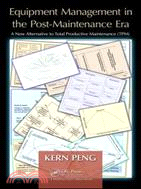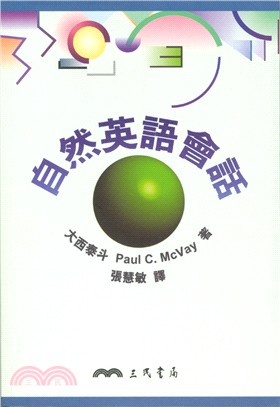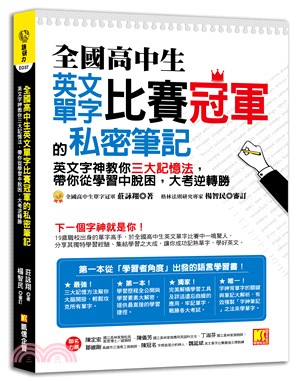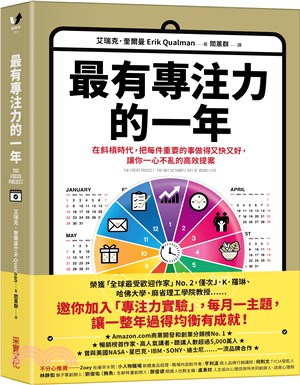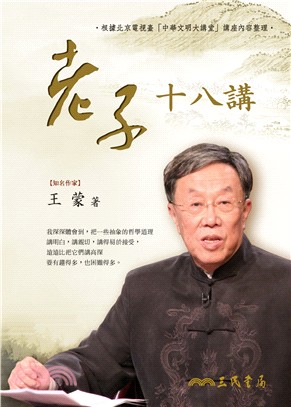Equipment Management in the Post-maintenance Era ─ A New Alternative to Total Productive Maintenance (TPM)
商品資訊
定價
:NT$ 2079 元優惠價
:90 折 1871 元
無庫存,下單後進貨(到貨天數約45-60天)
可得紅利積點:56 點
相關商品
商品簡介
作者簡介
目次
商品簡介
Recent advancements in information systems and computer technology have led to developments in equipment and robotic technology that have permanently changed the characteristics of manufacturing equipment. Equipment Management in the Post-Maintenance Era: A New Alternative to Total Productive Maintenance (TPM) introduces a new way of thinking to help high-tech organizations manage an increasingly complex equipment base. It also facilitates the fundamental understanding of equipment management those in traditional industries will need to prepare for the emerging microchip era in equipment.
Kern Peng shares insights gained through decades of managing equipment performance. Using a systems model to analyze equipment management, he introduces alternatives in equipment management that are currently gaining momentum in high-tech industries. The book highlights the fundamental internal flaw in maintenance organizational setup, presents new approaches to replace maintenance functional setup, and illustrates a time-tested transformation and implementation process to help transition your organization from the maintenance era to the new post-maintenance era.
Breaks down the history of equipment into five phases
Provides a clear understanding of equipment management fundamentals
Introduces alternatives in equipment management beyond the mainstream principles of maintenance management
The book examines maintenance management logistics, including planning and budgeting, training and people development, customer services and management, vendor management, and inventory management. Supplying a comprehensive look at the history of equipment management, it analyzes current maintenance practice and details approaches that can significantly improve the effectiveness and efficiency of your equipment management well into the future.
Kern Peng shares insights gained through decades of managing equipment performance. Using a systems model to analyze equipment management, he introduces alternatives in equipment management that are currently gaining momentum in high-tech industries. The book highlights the fundamental internal flaw in maintenance organizational setup, presents new approaches to replace maintenance functional setup, and illustrates a time-tested transformation and implementation process to help transition your organization from the maintenance era to the new post-maintenance era.
Breaks down the history of equipment into five phases
Provides a clear understanding of equipment management fundamentals
Introduces alternatives in equipment management beyond the mainstream principles of maintenance management
The book examines maintenance management logistics, including planning and budgeting, training and people development, customer services and management, vendor management, and inventory management. Supplying a comprehensive look at the history of equipment management, it analyzes current maintenance practice and details approaches that can significantly improve the effectiveness and efficiency of your equipment management well into the future.
作者簡介
Dr. Kern Peng holds two doctorate degrees, one in mechanical engineering specializing in nanocomposite materials, and the other in business administration specializing in operations management. He also holds an MBA in computer information systems and a BS in industrial engineering.
Dr. Peng designed and has been teaching the Equipment Management course at Santa Clara University, Santa Clara, California, since 2001. In addition, he regularly teaches four other master level courses in engineering management at SCU. Before that, he also taught MIS courses at San Jose State University, San Jose, California.
Dr. Peng has more than 26 years of people and project management experience in engineering and manufacturing, with over 19 years at Intel Corporation. He has mastered all aspects of engineering and manufacturing management and has proven results in finding innovative solutions to business and engineering problems. He has been accorded more than 50 career awards in the areas of engineering design; software development; technical paper publication; problem resolution; project management and execution; teamwork; and leadership.
Dr. Peng designed and has been teaching the Equipment Management course at Santa Clara University, Santa Clara, California, since 2001. In addition, he regularly teaches four other master level courses in engineering management at SCU. Before that, he also taught MIS courses at San Jose State University, San Jose, California.
Dr. Peng has more than 26 years of people and project management experience in engineering and manufacturing, with over 19 years at Intel Corporation. He has mastered all aspects of engineering and manufacturing management and has proven results in finding innovative solutions to business and engineering problems. He has been accorded more than 50 career awards in the areas of engineering design; software development; technical paper publication; problem resolution; project management and execution; teamwork; and leadership.
目次
INTRODUCTION TO EQUIPMENT MANAGEMENT
IntroductionBackgroundMaintenance ManagementEquipment ManagementKey Equipment Terminology Equipment States Equipment Time Equipment Actions Equipment Failure Patterns Equipment Performance Measurements
History of Equipment ManagementIntroductionPhase 1: Breakdown ManagementPhase 2: Preventive MaintenancePhase 3: Productive MaintenancePhase 4: Total Productive MaintenancePhase 5: TPM with Predictive MaintenanceSummary of the Pre-maintenance and Maintenance Phases
Introduction to the Post-Maintenance EraThe New Business Environment Operational Changes Equipment Characteristics New Enabling Technologies New Management ConceptsThe Issues of Maintenance Problems in Objectives Structural Inefficiency Unsuitable for Changing EnvironmentIntroduction to Phase 6: Post-Maintenance Era
THE MAINTENANCE SYSTEM
General Maintenance Concepts and PracticesIntroduction Preventive Maintenance Preventive Maintenance Schedule Preventive Maintenance Task List Preventive Maintenance Staffing Requirements Preventive Maintenance Equipment/Tool Requirements Preventive Maintenance Materials/Parts Requirements Preventive Maintenance Information SystemReliability-Centered MaintenancePredictive MaintenanceMaintenance PreventionTotal Productive MaintenanceTerotechnology
Maintenance Management LogisticsIntroductionPlanning and BudgetingStrategic Planning in MaintenanceHeadcount PlanBudget PlanTactical Planning in MaintenanceTraining and People DevelopmentCustomer Services and ManagementVendor, Supplier, and Contract ManagementInventory Management
Maintenance Performance IndicatorsIntroductionEquipment Performance Indicators Safety Indicators Purpose Format and Variation Presentation Availability Indicators Purpose Format and Variation Presentation Reliability Indicators Purpose Format and Variation Presentation Maintainability Indicators Purpose Format and Variation Presentation Utilization Indicators Purpose Format and Variation PresentationProcess Performance Indicators Labor Productivity Indicators Purpose Format and Variation Presentation Nonproductive Downtime Indicators Purpose Format and Variation Presentation Customer Satisfaction Indicators Purpose Format and Variation Presentation Operational Misses and Error Rates Purpose Format and Variation PresentationCost Performance Indicators Cost Rates Purpose Format and Variation Presentation Cost Breakdown by Categories Purpose Format and Variation Presentation
Computerized Maintenance Management SystemsIntroductionCMMS ObjectivesCMMS Functions Equipment Module Work Order Module Preventive Maintenance Module Safety Module Labor Module Inventory Module Financial Module Calendar ModuleCMMS Features Assessibility and Security Communication and Notification Data Entry and Presentation Integration Flexibility and CustomizationCMMS Implementation
THE POST-MAINTENANCE ERA
The Systems View of the Equipment Management ProcessIntroductionEnvironmental SuprasystemGoals and Values SubsystemStructural SubsystemTechnical SubsystemPsychosocial SubsystemManagerial Subsystem
New Changes in the Post-Maintenance EraIntroductionEquipment Management Objectives Functional-Level Objectives Job-Level ObjectivesOrganizational Structure ChangesThe Platform Ownership ConceptEmployee Skill RequirementsComputerized Equipment Management SystemsWork Environment ChangesManagement ChangesSummarizing the Post-Maintenance Era
Transformation and ImplementationIntroductionEnvironmental StudiesManagerial PreparednessGoal and Value ChangesPsychosocial ChangesTechnical ChangesStructural ChangesGlossaryReferences
IntroductionBackgroundMaintenance ManagementEquipment ManagementKey Equipment Terminology Equipment States Equipment Time Equipment Actions Equipment Failure Patterns Equipment Performance Measurements
History of Equipment ManagementIntroductionPhase 1: Breakdown ManagementPhase 2: Preventive MaintenancePhase 3: Productive MaintenancePhase 4: Total Productive MaintenancePhase 5: TPM with Predictive MaintenanceSummary of the Pre-maintenance and Maintenance Phases
Introduction to the Post-Maintenance EraThe New Business Environment Operational Changes Equipment Characteristics New Enabling Technologies New Management ConceptsThe Issues of Maintenance Problems in Objectives Structural Inefficiency Unsuitable for Changing EnvironmentIntroduction to Phase 6: Post-Maintenance Era
THE MAINTENANCE SYSTEM
General Maintenance Concepts and PracticesIntroduction Preventive Maintenance Preventive Maintenance Schedule Preventive Maintenance Task List Preventive Maintenance Staffing Requirements Preventive Maintenance Equipment/Tool Requirements Preventive Maintenance Materials/Parts Requirements Preventive Maintenance Information SystemReliability-Centered MaintenancePredictive MaintenanceMaintenance PreventionTotal Productive MaintenanceTerotechnology
Maintenance Management LogisticsIntroductionPlanning and BudgetingStrategic Planning in MaintenanceHeadcount PlanBudget PlanTactical Planning in MaintenanceTraining and People DevelopmentCustomer Services and ManagementVendor, Supplier, and Contract ManagementInventory Management
Maintenance Performance IndicatorsIntroductionEquipment Performance Indicators Safety Indicators Purpose Format and Variation Presentation Availability Indicators Purpose Format and Variation Presentation Reliability Indicators Purpose Format and Variation Presentation Maintainability Indicators Purpose Format and Variation Presentation Utilization Indicators Purpose Format and Variation PresentationProcess Performance Indicators Labor Productivity Indicators Purpose Format and Variation Presentation Nonproductive Downtime Indicators Purpose Format and Variation Presentation Customer Satisfaction Indicators Purpose Format and Variation Presentation Operational Misses and Error Rates Purpose Format and Variation PresentationCost Performance Indicators Cost Rates Purpose Format and Variation Presentation Cost Breakdown by Categories Purpose Format and Variation Presentation
Computerized Maintenance Management SystemsIntroductionCMMS ObjectivesCMMS Functions Equipment Module Work Order Module Preventive Maintenance Module Safety Module Labor Module Inventory Module Financial Module Calendar ModuleCMMS Features Assessibility and Security Communication and Notification Data Entry and Presentation Integration Flexibility and CustomizationCMMS Implementation
THE POST-MAINTENANCE ERA
The Systems View of the Equipment Management ProcessIntroductionEnvironmental SuprasystemGoals and Values SubsystemStructural SubsystemTechnical SubsystemPsychosocial SubsystemManagerial Subsystem
New Changes in the Post-Maintenance EraIntroductionEquipment Management Objectives Functional-Level Objectives Job-Level ObjectivesOrganizational Structure ChangesThe Platform Ownership ConceptEmployee Skill RequirementsComputerized Equipment Management SystemsWork Environment ChangesManagement ChangesSummarizing the Post-Maintenance Era
Transformation and ImplementationIntroductionEnvironmental StudiesManagerial PreparednessGoal and Value ChangesPsychosocial ChangesTechnical ChangesStructural ChangesGlossaryReferences
主題書展
更多
主題書展
更多書展本週66折
您曾經瀏覽過的商品
購物須知
外文書商品之書封,為出版社提供之樣本。實際出貨商品,以出版社所提供之現有版本為主。部份書籍,因出版社供應狀況特殊,匯率將依實際狀況做調整。
無庫存之商品,在您完成訂單程序之後,將以空運的方式為你下單調貨。為了縮短等待的時間,建議您將外文書與其他商品分開下單,以獲得最快的取貨速度,平均調貨時間為1~2個月。
為了保護您的權益,「三民網路書店」提供會員七日商品鑑賞期(收到商品為起始日)。
若要辦理退貨,請在商品鑑賞期內寄回,且商品必須是全新狀態與完整包裝(商品、附件、發票、隨貨贈品等)否則恕不接受退貨。



